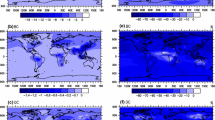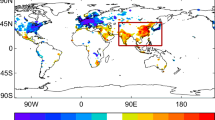Abstract
We used an online aerosol–climate model to study the equilibrium climate response of the East Asian summer monsoon (EASM) to increases in anthropogenic emissions of sulfate, organic carbon, and black carbon aerosols from 1850 to 2000. Our results show that each of these aerosol species has a different effect on the EASM as a result of changes in the local sea–land thermal contrast and atmospheric circulation. The increased emission of sulfate aerosol leads to a decrease in the thermal contrast between the land and ocean, a southward shift of the East Asian subtropical jet, and significant northerly wind anomalies at 850 hPa over eastern China and the ambient oceans, markedly dampening the EASM. An increase in organic carbon aerosol results in pronounced surface cooling and the formation of an anomalous anticyclone over the oceans north of 30°N. These effects cause a slight increase in the sea–land thermal contrast and southerly flow anomalies to the west of the anticyclonic center, strengthening the northern EASM. An increase in organic carbon emission decreases the sea–land thermal contrast over southern China, which weakens the southern EASM. The response of the summer 850-hPa winds and rainfall over the East Asian monsoon region to an increase in black carbon emission is generally consistent with the response to an increase in organic carbon. The increase in black carbon emission leads to a strengthening of the northern EASM north of 35°N and a slight weakening of the southern EASM south of 35°N. The simulated response of the EASM to the increase in black carbon emission is unchanged when the emission of black carbon is scaled up by five times its year 2000 levels, although the intensities of the response is enhanced. The increase in sulfate emission primarily weakens the EASM, whereas the increases in black carbon and organic carbon emissions mitigate weakening of the northern EASM.
Similar content being viewed by others
References
Albrecht, B. A., 1989: Aerosols, cloud microphysics, and fractional cloudiness. Science, 245, 1227–1231, doi: 10.1126/science.245.4923.1227.
Cohen, J. B., and C. E. Wang, 2014: Estimating global black carbon emissions using a top-down Kalman filter approach. J. Geophys. Res., 119, 307–323, doi: 10.1002/2013JD019912.
Dai, A. G., H. M. Li, Y. Sun, et al., 2013: The relative roles of upper and lower tropospheric thermal contrasts and tropical influences in driving Asian summer monsoons. J. Geophys. Res. Atmos., 118, 7024–7045, doi: 10.1002/jgrd.50565.
Ding, Y. H., and J. C. L. Chan, 2005: The East Asian summer monsoon: An overview. Meteor. Atmos. Phys., 89, 117–142, doi: 10.1007/s00703-005-0125-z.
Fu, C. B., 2003: Potential impacts of human-induced land cover change on East Asian monsoon. Global Planet. Change, 37, 219–229, doi: 10.1016/S0921-8181(02)00207-2.
Ganguly, D., P. J. Rasch, H. L. Wang, et al., 2012a: Fast and slow responses of the South Asian monsoon system to anthropogenic aerosols. Geophys. Res. Lett., 39, L18804, doi: 10.1029/2012GL053043.
Ganguly, D., P. J. Rasch, H. L. Wang, et al., 2012b: Climate response of the South Asian monsoon system to anthropogenic aerosols. J. Geophys. Res. Atmos., 117, D13209, doi: 10.1029/2012JD017508.
Guo, L., E. J. Highwood, L. C. Shaffrey, et al., 2013: The effect of regional changes in anthropogenic aerosols on rainfall of the East Asian summer monsoon. Atmos. Chem. Phys., 13, 1521–1534, doi: 10.5194/acp-13-1521-2013.
Guo, L., A. G. Turner, and E. J. Highwood, 2016: Local and remote impacts of aerosol species on Indian summer monsoon rainfall in a GCM. J. Climate, 29, 6937–6955, doi: 10.1175/JCLI-D-15-0728.1.
Haywood, J. M., and V. Ramaswamy, 1998: Global sensitivity studies of the direct radiative forcing due to anthropogenic sulfate and black carbon aerosols. J. Geophys. Res. Atmos., 103, 6043–6058, doi: 10.1029/97JD03426.
IPCC, 2013: Climate Change 2013: The Physical Science Basis. Contribution of Working Group I to the Fifth Assessment Report of the Intergovernmental Panel on Climate Change. Stocker, T. F., et al., Eds. Cambridge University Press, Cambridge, UK, 1535 pp.
Jiang, Y. Q., X. H. Liu, X. Q. Yang, et al., 2013: A numerical study of the effect of different aerosol types on East Asian summer clouds and precipitation. Atmos. Environ., 70, 51–63, doi: 10.1016/j.atmosenv.2012.12.039.
Koch, D., and A. D. Del Genio, 2010: Black carbon semi-direct effects on cloud cover: Review and synthesis. Atmos. Chem. Phys., 10, 7685–7696, doi: 10.5194/acp-10-7685-2010.
Lamarque, J. F., T. C. Bond, V. Eyring, et al., 2010: Historical (1850–2000) gridded anthropogenic and biomass burning emissions of reactive gases and aerosols: Methodology and application. Atmos. Chem. Phys., 10, 7017–7039, doi: 10.5194/acp-10-7017-2010.
Lau, K. M., M. K. Kim, and K. M. Kim, 2006: Asian summer monsoon anomalies induced by aerosol direct forcing: The role of the Tibetan Plateau. Climate Dyn., 26, 855–864, doi: 10.1007/s00382-006-0114-z.
Li, H. M., A. G. Dai, T. J. Zhou, et al., 2010: Responses of East Asian summer monsoon to historical SST and atmospheric forcing during 1950–2000. Climate Dyn., 34, 501–514, doi: 10.1007/s00382-008-0482-7.
Li, Z. Q., W. K.-M. Lau, V. Ramanathan, et al., 2016: Aerosol and monsoon climate interactions over Asia. Rev. Geophys., 54, 866–929, doi: 10.1002/2015RG000500.
Liu, X. D., X. N. Xie, Z.-Y. Yin, et al., 2011: A modeling study of the effects of aerosols on clouds and precipitation over East Asia. Theor. Appl. Climatol., 106, 343–354, doi: 10.1007/s00704-011-0436-6.
Menon, S., J. Hansen, L. Nazarenko, et al., 2002: Climate effects of black carbon aerosols in China and India. Science, 297, 2250–2253, doi: 10.1126/science.1075159.
Morrison, H., and A. Gettelman, 2008: A new two-moment bulk stratiform cloud microphysics scheme in the community atmosphere model, version 3 (CAM3). Part I: Description and numerical tests. J. Climate, 21, 3642–3659, doi: 10.1175/2008JCLI2105.1.
Myhre, G., B. H. Samset, M. Schulz, et al., 2013: Radiative forcing of the direct aerosol effect from AeroCom Phase II simulations. Atmos. Chem. Phys., 13, 1853–1877, doi: 10.5194/acp-13-1853-2013.
Qian, C., and T. J. Zhou, 2014: Multidecadal variability of North China aridity and its relationship to PDO during 1900–2010. J. Climate, 27, 1210–1222, doi: 10.1175/JCLI-D-13-00235.1.
Salzmann, M., H. Weser, and R. Cherian, 2014: Robust response of Asian summer monsoon to anthropogenic aerosols in CMIP5 models. J. Geophys. Res. Atmos., 119, 11321–11337, doi: 10.1002/2014JD021783.
Song, F. F., T. J. Zhou, and Y. Qian, 2014: Responses of East Asian summer monsoon to natural and anthropogenic forcings in the 17 latest CMIP5 models. Geophys. Res. Lett., 41, 596–603, doi: 10.1002/2013GL058705.
Twomey, S., 1977: The influence of pollution on the shortwave albedo of clouds. J. Atmos. Sci., 34, 1149–1154, doi: 10.1175/1520-0469(1977)034<1149:TIOPOT>2.0.CO;2.
Wang, Q. Y., Z. L. Wang, and H. Zhang, 2017: Impact of anthropogenic aerosols from global, East Asian, and non-East Asian sources on East Asian summer monsoon system. Atmos. Res., 183, 224–236, doi: 10.1016/j.atmosres.2016.08.023.
Wang, T. J., B. L. Zhuang, S. Li, et al., 2015: The interactions between anthropogenic aerosols and the East Asian summer monsoon using RegCCMS. J. Geophys. Res. Atmos., 120, 5602–5621, doi: 10.1002/2014JD022877.
Wang, Z. L., H. Zhang, J. N. Li, et al., 2013a: Radiative forcing and climate response due to the presence of black carbon in cloud droplets. J. Geophys. Res. Atmos., 118, 3662–3675, doi: 10.1002/jgrd.50312.
Wang, Z. L., H. Zhang, X. W. Jing, et al., 2013b: Effect of nonspherical dust aerosol on its direct radiative forcing. Atmos. Res., 120–121, 112–126, doi: 10.1016/j.atmosres.2012.08.006.
Wang, Z. L., H. Zhang, and P. Lu, 2014: Improvement of cloud microphysics in the aerosol–climate model BCC_AGCM2.0.1_ CUACE/Aero, evaluation against observations, and updated aerosol indirect effect. J. Geophys. Res. Atmos., 119, 8400–8417, doi: 10.1002/2014JD021886.
Wang, Z. L., H. Zhang, and X. Y. Zhang, 2015: Simultaneous reductions in emissions of black carbon and co-emitted species will weaken the aerosol net cooling effect. Atmos. Chem. Phys., 15, 3671–3685, doi: 10.5194/acp-15-3671-2015.
Wang, Z. L., H. Zhang, and X. Y. Zhang, 2016: Projected response of East Asian summer monsoon system to future reductions in emissions of anthropogenic aerosols and their precursors. Climate Dyn., 47, 1455–1468, doi: 10.1007/s00382-015-2912-7.
Wei, X. D., and H. Zhang, 2011: Analysis of optical properties of nonspherical dust aerosols. Acta Opt. Sinica, 31, 501002, doi: 10.3788/AOS201131.0501002.
Wu, G. X., Z. Q. Li, C. B. Fu, et al., 2016: Advances in studying interactions between aerosols and monsoon in China. Sci. China Earth Sci., 59, 1–16, doi: 10.1007/s11430-015-5198-z.
Wu, T. W., R. C. Yu, F. Zhang, et al., 2010: The Beijing Climate Center atmospheric general circulation model: Description and its performance for the present-day climate. Climate Dyn., 34, 123–147, doi: 10.1007/s00382-008-0487-2.
Xu, M., C.-P. Chang, C. B. Fu, et al., 2006: Steady decline of East Asian monsoon winds, 1969–2000: Evidence from direct ground measurements of wind speed. J. Geophys. Res. Atmos., 111, D24111, doi: 10.1029/2006JD007337.
Xu, Y., and S.-P. Xie, 2015: Ocean mediation of tropospheric response to reflecting and absorbing aerosols. Atmos. Chem. Phys., 15, 5827–5833, doi: 10.5194/acp-15-5827-2015.
Yu, R. C., B. Wang, and T. J. Zhou, 2004: Tropospheric cooling and summer monsoon weakening trend over East Asia. Geophys. Res. Lett., 31, L22212, doi: 10.1029/2004GL021270.
Zhang, H., Z. L. Wang, Z. Z. Wang, et al., 2012: Simulation of direct radiative forcing of aerosols and their effects on East Asian climate using an interactive AGCM–aerosol coupled system. Climate Dyn., 38, 1675–1693, doi: 10.1007/s00382-011-1131-0.
Zhang, H., X. W. Jing, and J. N. Li, 2014: Application and evaluation of a new radiation code under McICA scheme in BCC_AGCM2.0.1. Geosci. Model Dev., 7, 737–754, doi: 10.5194/gmd-7-737-2014.
Zhang, H., S. Y. Zhao, Z. L. Wang, et al., 2016: The updated effective radiative forcing of major anthropogenic aerosols and their effects on global climate at present and in the future. Int. J. Climatol., 36, 4029–4044, doi: 10.1002/joc.4613.
Zhao, S. Y., H. Zhang, S. Feng, et al., 2015: Simulating direct effects of dust aerosol on arid and semi-arid regions using an aerosol–climate coupled system. Int. J. Climatol., 35, 1858–1866, doi: 10.1002/joc.4093.
Zhou, C.-H., S. L. Gong, X.-Y. Zhang, et al., 2012: Towards the improvements of simulating the chemical and optical properties of Chinese aerosols using an online coupled model—CUACE/Aero. Tellus B, 64, 18965, doi: 10.3402/tellusb.v64i0.18965.
Author information
Authors and Affiliations
Corresponding author
Additional information
Supported by the National Key Research and Development Program of China (2017YFA0603503) and National Natural Science Foundation of China (41575139, 91644211, and 41575002).
Rights and permissions
About this article
Cite this article
Wang, Z., Wang, Q. & Zhang, H. Equilibrium climate response of the East Asian summer monsoon to forcing of anthropogenic aerosol species. J Meteorol Res 31, 1018–1033 (2017). https://doi.org/10.1007/s13351-017-7059-5
Received:
Accepted:
Published:
Issue Date:
DOI: https://doi.org/10.1007/s13351-017-7059-5




